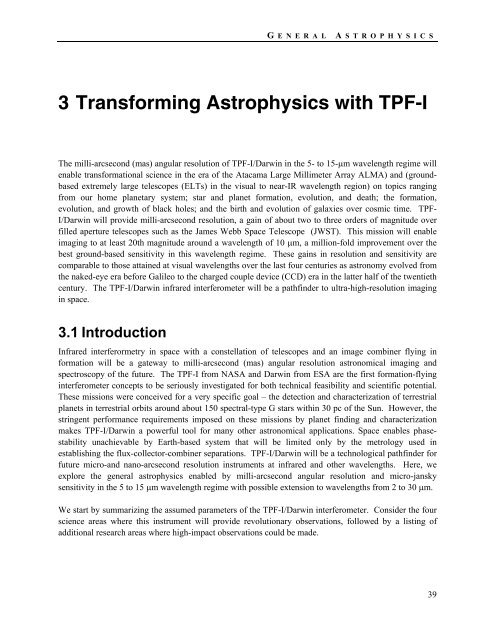TPF-I SWG Report - Exoplanet Exploration Program - NASA
TPF-I SWG Report - Exoplanet Exploration Program - NASA
TPF-I SWG Report - Exoplanet Exploration Program - NASA
Create successful ePaper yourself
Turn your PDF publications into a flip-book with our unique Google optimized e-Paper software.
G ENERAL A STROPHYSICS<br />
3 Transforming Astrophysics with <strong>TPF</strong>-I<br />
The milli-arcsecond (mas) angular resolution of <strong>TPF</strong>-I/Darwin in the 5- to 15-μm wavelength regime will<br />
enable transformational science in the era of the Atacama Large Millimeter Array ALMA) and (groundbased<br />
extremely large telescopes (ELTs) in the visual to near-IR wavelength region) on topics ranging<br />
from our home planetary system; star and planet formation, evolution, and death; the formation,<br />
evolution, and growth of black holes; and the birth and evolution of galaxies over cosmic time. <strong>TPF</strong>-<br />
I/Darwin will provide milli-arcsecond resolution, a gain of about two to three orders of magnitude over<br />
filled aperture telescopes such as the James Webb Space Telescope (JWST). This mission will enable<br />
imaging to at least 20th magnitude around a wavelength of 10 μm, a million-fold improvement over the<br />
best ground-based sensitivity in this wavelength regime. These gains in resolution and sensitivity are<br />
comparable to those attained at visual wavelengths over the last four centuries as astronomy evolved from<br />
the naked-eye era before Galileo to the charged couple device (CCD) era in the latter half of the twentieth<br />
century. The <strong>TPF</strong>-I/Darwin infrared interferometer will be a pathfinder to ultra-high-resolution imaging<br />
in space.<br />
3.1 Introduction<br />
Infrared interferormetry in space with a constellation of telescopes and an image combiner flying in<br />
formation will be a gateway to milli-arcsecond (mas) angular resolution astronomical imaging and<br />
spectroscopy of the future. The <strong>TPF</strong>-I from <strong>NASA</strong> and Darwin from ESA are the first formation-flying<br />
interferometer concepts to be seriously investigated for both technical feasibility and scientific potential.<br />
These missions were conceived for a very specific goal – the detection and characterization of terrestrial<br />
planets in terrestrial orbits around about 150 spectral-type G stars within 30 pc of the Sun. However, the<br />
stringent performance requirements imposed on these missions by planet finding and characterization<br />
makes <strong>TPF</strong>-I/Darwin a powerful tool for many other astronomical applications. Space enables phasestability<br />
unachievable by Earth-based system that will be limited only by the metrology used in<br />
establishing the flux-collector-combiner separations. <strong>TPF</strong>-I/Darwin will be a technological pathfinder for<br />
future micro-and nano-arcsecond resolution instruments at infrared and other wavelengths. Here, we<br />
explore the general astrophysics enabled by milli-arcsecond angular resolution and micro-jansky<br />
sensitivity in the 5 to 15 μm wavelength regime with possible extension to wavelengths from 2 to 30 μm.<br />
We start by summarizing the assumed parameters of the <strong>TPF</strong>-I/Darwin interferometer. Consider the four<br />
science areas where this instrument will provide revolutionary observations, followed by a listing of<br />
additional research areas where high-impact observations could be made.<br />
39
















